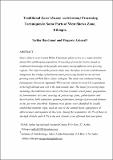| dc.identifier.citation | Hunduma, T. and Ashenafi, M. (2011) Traditional Enset (Ensete ventricosum) processing techniques in some parts of West Shewa Zone, Ethiopia, Journal of Agriculture and Development (JAD), vol. 2, no. 1, pp. 37-57. Addis Ababa: St. Mary's University. | en |
| dc.description.abstract | Enset, (Ensete ventricosum Welw) Cheesman, plant serves as a staple food for about 20% of Ethiopian population. Processing of enset for food is based on traditional knowledge of the people and varies among different enset growing regions. The objective of the present study was, therefore, to assess and document indigenous knowledge of traditional enset processing method in one of enset growing areas of West Shewa Zone, Ethiopia. The study was conducted using Participatory Research Appraisal (PRA) system. which involved 132 respondents in the high altitude and 126 in the mid-attitude sites. The major processing steps, including, the traditional tools used, selection of mature enset plants, preparation of fermentation pits and clearing of processing spots, pulverization and decortication, bulla extraction, gamma preparation, storage of processed biomass in the pit were described. Matured enset plants were identified by locally established maturity signs, such as, size of the central shoot, appearance of inflorescence and exposure of the corm. Among the respondents, 62.1% of those in the high altitude and 93.6% in the mid altitude areas affirmed that enset plant
1 EIAR, Ambo Agricultural Research Center, P. O. Box, 37, Ambo,
Ethiopia tarikuh2002@yahoo.com
2
Institute of Pathobiology, Addis Ababa University, P.O.Box 1176, Addis Ababa, Ethiopia mogessie@gmail.com
38 Tariku Hunduma and Mogessie Ashenafi
reaches maturity between the age of four and seven years, while the remaining of the respondents claimed that it takes eight or more years to reach maturity. Traditionally, enset fermentation takes place in an earthen pit. October to early December was considered to be the appropriate time for processing. Traditional knowledge of enset processing has been generally owned by women and the processing is normally unthinkable without them, signifying their role in securing food supply for the households. Traditional enset processing is tedious, labour intensive, unhygienic and is done using local tools with a lot of similarities in basic steps of processing among different localities. This age-old processing of enset would require the concerted effort of food microbiologists and food processing technologists to lessen the pressure on women and to avoid spoilage during fermentation in order to produce wholesome products. The important traditional practices of enset processing that have been revealed during the present study could be utilized as an information to improve the traditional processes, thus, eventually contributing to food security. | en |


